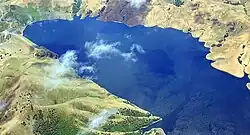Twitchell Reservoir
Twitchell Reservoir is a reservoir in southern San Luis Obispo County and northern Santa Barbara County in California. The reservoir has a capacity of 197,756 acre⋅ft (243,928,000 m3) and is formed by Twitchell Dam on the Cuyama River about 66 miles (106 km) from its headwaters in the Chumash Wilderness Area. About 7 miles (11 km) below the dam, outflow joins the Sisquoc River near Gary, CA to form the Santa Maria River.
| Twitchell Reservoir | |
|---|---|
 Twitchell Reservoir  Twitchell Reservoir | |
| Location | San Luis Obispo / Santa Barbara counties, California, United States |
| Coordinates | 34°59′53″N 120°19′59″W |
| Type | Reservoir |
| Primary inflows | Cuyama River / Huasna River |
| Primary outflows | Terminal (evaporation) / Cuyama River |
| Basin countries | United States |
| Water volume | 225,000 acre⋅ft (278,000,000 m3) |
| Surface elevation | 692 ft (211 m) |
| References | "Twitchell Reservoir". Geographic Names Information System. United States Geological Survey, United States Department of the Interior. |



Twitchell Dam was built by the United States Bureau of Reclamation between 1956 and 1958. The original names were Vacquero Dam and Vacquero Reservoir, but they were changed to honor T. A. Twitchell of Santa Maria, a proponent of the project. The dam and reservoir provide flood control and water conservation.
The Central Coast of California only receives significant amounts of rainfall during the winter, this area averaging 14 inches (360 mm) per year. The water is stored in the reservoir during big winter storms and released as quickly as possible while still allowing it to percolate into the soil and recharge the groundwater. This means that the reservoir is usually far from full. It is estimated that the project increases recharge by 20,000 acre⋅ft (25,000,000 m3) annually.
Sedimentation is a problem for the reservoir, as the reservoir is being filled 70 percent faster than expected. This reduces its capacity and blocks the water inlet to the control gates. Some sediment has been removed by flushing it out during releases, but much of it is simply deposited immediately downstream, interfering with flows.
There is no public access to the dam or reservoir.[1]